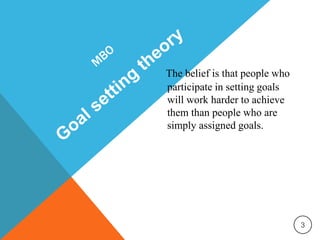Presentation on motivation from concept to application
- 1. WELCOME TO OUR PRESENTATION ON MOTIVATION FROM CONCEPT TO APPLICATION F U T U R E E N T R E P R E N E U R S 1
- 2. THEORIES OF MOTIVATION E Q U I T Y T H E O R Y A major determinant of job satisfaction and performance of the individuals perception of the relationship between input and output. E X P E C T A N C Y T H E O R Y Individuals make decisions and behave according to what they believe; the outcome of a particular action will be based on how attractive that action is to them. 2
- 3. The belief is that people who participate in setting goals will work harder to achieve them than people who are simply assigned goals. 3
- 4. APPLICATION OF THEORIES Need for higher productivity in the industry . An appropriate amount of work to be accomplished within a period of time. Reward for accomplishing set of works or punishment for incomplete works. 4
- 6. WHY ARE STUDENTS DEMOTIVATED?? The student is demotivated because he or she cannot do the assigned work. The student is demotivated because the ‘response effort’ needed to complete the assigned work seems too great. The student is demotivated because of low self-efficacy— lacks of confidence that he or she can do the assigned work. 6
- 7. It is a fact that students don’t get chance to make positive relation with teachers. 7
- 8. WHY ARE STUDENTS DEMOTIVATED(CONT’D) The student is demotivated because classroom instruction does not engage. Sometimes teachers forget that students are also human being!!!! 8
- 9. A student will not be motivated to attend class if she/he doesn’t care about grades. 9
- 10. Indifferent or even hostile toward the instructor and thus may lack motivation to follow teacher requests or to produce work. 10
- 11. HOW TO IDENTIFY DEMOTIVATED STUDENTS??? The student has a low sense of self-efficacy and lack of confidence. 11
- 12. HOW CAN YOU UNDERSTAND THAT YOU ARE DEMOTIVATED 12
- 13. HOW TO MOTIVATE? Ensure that the lesson content is appropriately matched to students’ abilities. Open the lesson with a brief review of concepts or material that was previously presented. States the goals of the current day’s lesson. 13
- 14. HOW TO MOTIVATE? Provide timely and regular performance feedback and corrections. Break a larger student assignment into smaller ‘chunks’. 14
- 15. Praise for each completed ‘chunk’ of assigned work. Provide increased doses of positive attention at times when the student is engaging in appropriate behavior. 15
- 16. HOW TO MOTIVATE? Commit to a Short Series of Positive ‘Micro-Conversations’. Avoid using negative phrasing (If you don't) 16
- 17. EXTRINSIC MOTIVATION Extrinsic motivation includes outside motivational forces that push students to work hard. For students, extrinsic motivators come in the form of grades, parental, teacher, and social expectations. However, extrinsic motivators are not as effective as motivators that result from self-determination. 17
- 18. INTRINSIC MOTIVATION Intrinsic motivation comes from within, and is the most effective form of motivation for learners. A student's personal interest in the material is what drives them to be good students. Teachers are instrumental in reinforcing intrinsic motivators for students by showing that hard work and determination has a big payoff past high school. 18
- 19. EMPLOYEE RECOGNITION PROGRAMS In addition to pay there are intrinsic rewards Can be as simple as a spontaneous comment Can be formalized in a program. Recognition is the most powerful workplace motivator – and the least expensive! 19
- 20. Reward system for employees that address these four areas: compensation, benefits, recognition and appreciation. 20
- 21. 21
- 23. WHAT TO PAY • Need to establish a pay structure Balance between: Internal equity – the worth of the job to the organization External equity – the external competitiveness of an organization’s pay relative to pay elsewhere in its industry A strategic decision with trade-offs 23
- 24. HOW TO PAY Bases a portion of the pay on a given measure of performance. Piece-Rate Pay – workers are paid a fixed sum for each unit of production completed. Merit-Based Pay – pay is based on individual performance appraisal ratings. Bonuses – rewards employees for recent performance Skill-Based Pay – pay is based on skills acquired instead of job title or rank – doesn’t address the level of performance. 24
- 25. VARIABLE PAY PROGRAMS Profit-Sharing Plans – organization-wide programs that distribute compensation based on an established formula designed around profitability Gain sharing – compensation based on sharing of gains from improved productivity Employee Stock Ownership Plans (ESOPs) – plans in which employees acquire stock, often at below-market prices 25
- 26. THANK YOU ALL FOR BEING WITH US WITH YOUR ATTENTION 26


























